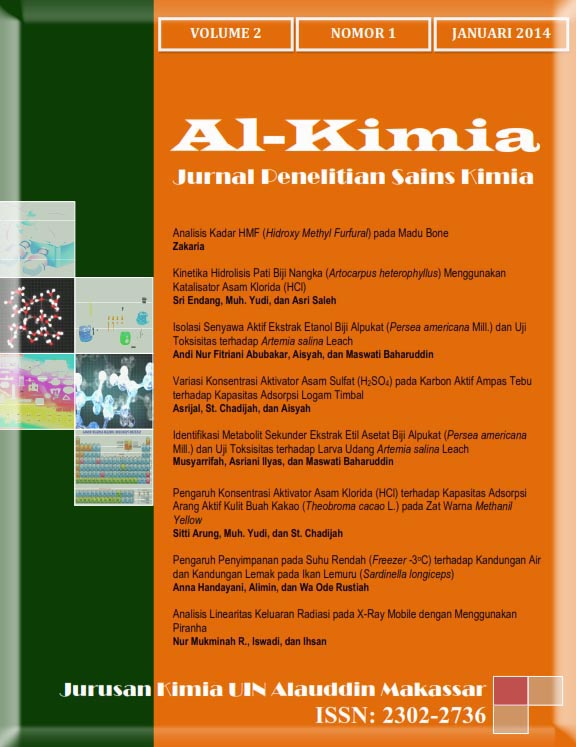Analisis Kadar HMF (Hidroxy Methyl Furfural) pada Madu Bone
Abstract
This study aimed to determine the concentration of HMF ((hydroxy methyl furfural) in Bone honey. Regency Bone with 145.073 ha of forest, of area 4,559 km² honey potential for livestock development. The quality of honey is determined from the nectar source, geographic location, and the processing technology. HMF concentration is one of the indicators in honey to determine the quality marker and freshness of honey. This research was done in three stages, namely the stage of sample preparation, extraction phase, and phase identification. Stages of sample preparation were performed to determine sampling locations, the determination of the location of the extraction and identification. Extraction is done in analytical chemistry laboratorium Science Faculty, Hasanuddin University. Honey samples were extracted with methanol. The identification process carried out in an integrated laboratory Department of Chemical Science Faculty of Hasanuddin University to obtain the data of UV-Vis, HPLC performed while the data in an integrated laboratory public health, Hasanuddin University. The results obtained by HPLC showed the data HMF concentration of 0.264 mg/kg, while the data obtained by UV-Vis HMF concentration of 0.230 mg/kg. Based on these data concluded that honey Bone has a good quality in terms of content HMF.Downloads
References
Adriana C, Purcarea C, 2011, The Effect Of Thermal Tratament On Fresh Monofloral Honey Types From Bihor County, University of Oradea, Faculty of Environment Protection Oradea.
Almatsier, Sunita, 2004, Prinsip Dasar Ilmu Gizi, Jakarta: Gramedia.
Badan Standarisasi Nasional Indonesia, 2004, Sni-01-3545-2004: Madu, Badan Standarisasi nasional indonesia, Jakarta.
Barra, et al, 2010, Volatile Compounds In Honey Produced In The Central Valley Of Ñuble Province, Chile, Chilean Journal Of Agricultural Research (Online) 70 (1): 75-84 (January-March 2010), diakses 7 September 2013.
Bayraktar, 2011, Investigation Of The Aroma Impact Volatiles In Turkish Pine Honey Samples Produced In Marmaris, Datc¸A And Fethiye Regions By Spme⁄Gc⁄Ms Technique, International Journal of Food Science and Technology (Online), 46: 1060–1065, diakses 7 September 2013.
Harli, M., 2001, Madu yang Asli dan yang Palsu, (online) http://id.shvoong.com, diakses 16 Agustus 2013.
Khalil Ml, Sulaiman Sa, Gan SH. 2010. High 5-Hydroxymethylfurfural Concentration Are Found In Malaysian Honey Samples Stored For More Than One Year. Journal International Food Chem Toxical (online) 48: 2388-2392, diakses 15 Oktober 2013.
Mahmud, A., 2008, Pengembangan Lebah Madu Dalam Rangka Gerakan Pembangunan Masyarakat Di Provinsi Sulawesi Selatan, Dinas Kehutanan Provinsi Sulawesi Selatan, Jurnal Hutan Dan Masyarakat (online) Vol. III No. 1 Mei 2008, 001-110, diakses 5 Nopember 2013.
Molan, P, C., 2006, The Evidence Supporting The Use Of Honey As A Wound Dressing. J. Sci. Lower Extremity Wound (online) 5 (1): 40-54, diakses 15 Oktober 2013.
Suarez, 2010, Contribution Of Honey In Nutrition And Human Health: A Review, Mediterr j nutr metab (online) 3:15–23, diakses 5 Oktober 2013.
Authors who publish with this journal agree to the following terms:
1) Authors retain copyright and grant the journal right of first publication with the work simultaneously licensed under a Creative Commons Attribution License that allows others to share the work with an acknowledgement of the work's authorship and initial publication in this journal.
2) Authors are able to enter into separate, additional contractual arrangements for the non-exclusive distribution of the journal's published version of the work (e.g., post it to an institutional repository or publish it in a book), with an acknowledgement of its initial publication in this journal.
3)Authors are permitted and encouraged to post their work online (e.g., in institutional repositories or on their website) prior to and during the submission process, as it can lead to productive exchanges, as well as earlier and greater citation of published work (See The Effect of Open Access).


